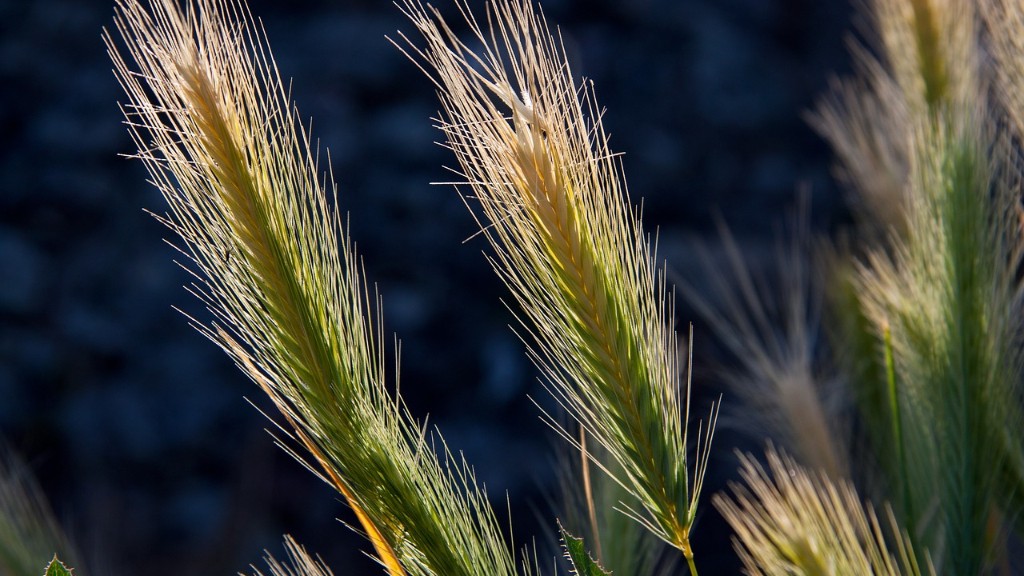Technology has impacted agriculture in many ways. It has allowed for more precise and efficient farming techniques, which has in turn increased yields and lowered costs. It has also made it possible to monitor crops and soil more closely, as well as to automatically control irrigation systems.
Technology has created many young entrepreneurs who are now farming with innovative approaches.
Agriculture has experienced increased mechanization and more efficient use of inputs such as water, fertilizers, and herbicides.
Technology has also allowed for better genetic engineering of crops, resulting in higher yields and pest resistance.
What technology has had the biggest impact on agriculture?
Automated irrigation systems have greatly improved the efficiency of water distribution to crops, resulting in higher quality and quantity of agricultural production. These systems have revolutionized how water is supplied to crops, and have had a positive impact on agriculture as a whole.
The advances in machinery have led to more efficient and faster cultivation of land. The seed, irrigation, and fertilizers have also been improved, which has helped farmers increase their yields.
What are 5 examples of technologies used in agriculture
The agricultural industry is constantly evolving and adopting new technologies to improve efficiency and productivity. Here are five of the newest technologies being used in agriculture today:
1. GIS software and GPS: Agricultural businesses are using GIS software and GPS systems to map out their fields and track their equipment. This helps them to optimize their operations and make better decisions about where to plant, how to irrigate, and how to use their resources.
2. Satellite imagery: Farmers and ranchers are using satellite imagery to monitor their crops and grazing lands. This helps them to identify problems early and take action to correct them.
3. Drone and other aerial imagery: Drones are being used to take aerial photos of crops and fields. This gives farmers a bird’s eye view of their operations and helps them to identify problems quickly.
4. Farming software and online data: There are a number of software programs and online databases that farmers can use to track their operations. This information can help them to make better decisions about their crops and animals.
5. Merging datasets: Agricultural businesses are increasingly using data from different sources to create comprehensive models of their operations. This helps them to identify trends and make better decisions about how to run their business.
New technologies have helped to increase crop yields and decrease the impact on the environment. They have also helped to reduce the use of water, fertilizer and pesticides, which has kept food prices low. In addition, new technologies have helped to improve the safety of workers in the agricultural industry.
What are 3 examples of technology used in agricultural areas?
There are a number of emerging technologies that are set to transform the agriculture industry. These include:
1. Soil and water sensors: These allow farmers to monitor conditions in their fields in real-time, and make adjustments accordingly.
2. Weather tracking: This can help farmers to predict weather patterns and take steps to protect their crops.
3. Satellite imaging: This allows farmers to see detailed information about their crops, and make decisions about irrigation, planting, and more.
4. Pervasive automation: This refers to the use of sensors and other devices to automate tasks in the agriculture industry, such as field mapping and yield analysis.
5. Minichromosomal technology: This is a new type of genetically-modified organism (GMO) that can be used to create more resilient crops.
6. RFID technology: This can be used to track animals and crops, and to manage inventory.
7. Vertical farming: This is a type of agriculture that involves growing crops in vertically-stacked layers, in order to make better use of space.
With a rising global population and farm labor shortages, farm automation technology is becoming increasingly important. Some of the most common technologies being utilized by farms include harvest automation, autonomous tractors, seeding and weeding, and drones. These technologies can help farmers to improve efficiency and productivity, while also meeting changing consumer preferences.
What technologies improve farming?
As the world’s population continues to grow, there is an increasing need for food production. Smart farming technologies can help to increase yields and meet the demand.
IoT in agriculture can help to increase crop yields and improve efficiency. For example, sensors can be used to monitor soil moisture levels, pests, and weather conditions. This data can be used to optimize irrigation, pesticide use, and crop management.
Semi-automatic robots can help with tasks such as planting, weeding, and harvesting. Drones can be used for crop mapping and monitoring. Smart remote sensing can be used to detect crop conditions and gather data for analysis.
Computer imaging can be used to identify plant diseases and pests. This information can be used to take preventive action and improve yields.
Smart farming technologies can help to increase food production and meet the needs of a growing population.
The reaper, thresher, steam engine, combine, automobile, tractor, and hydraulics are all inventions that have changed the way farmers produce food. The reaper allowed farmers to harvest small grains much faster and more efficiently than ever before. The thresher made it possible to remove kernels from the straw quickly and easily. The steam engine made it possible for the combine to be used to harvest larger areas of land more quickly. The automobile allowed farmers to transport their goods to market much more quickly and easily. The tractor made it possible for farmers to plow their fields and haul their goods much more easily. Hydraulics made it possible for the tractor to be used in a variety of ways to help farmers with their work.
What are the top 5 technology innovation in agriculture
Agriculture is an essential sector of the economy, and innovation in this field is critical for the advancement of society as a whole. In the coming years, we can expect to see continued progress in the development of new technologies that will help farmers to increase yields, reduce costs, and improve the quality of their products. Here are 10 of the most exciting trends to watch out for in the field of agriculture technology:
1. Bee vectoring technologies – These technologies make use of bees to deliver crop-protecting chemicals directly to the plants, thereby reducing the amount of chemicals that need to be used overall.
2. Precision agriculture – This is a type of farming that relies on GPS and other forms of technology to precisely target inputs such as water, fertilizer, and pesticides, leading to a more efficient use of resources.
3. Indoor vertical farming – This type of farming allows crops to be grown indoors in a controlled environment, which can lead to higher yields and a year-round growing season.
4. Livestock farming technology – There are a number of new technologies being developed for livestock farmers, including sensors that help to monitor animal health, and automated systems for feeding and milking.
5. Laser scarec
As technology has advanced, so has agricultural equipment. The tractor was introduced as a way to mechanize farm work, followed by new tillage, harvesting, and irrigation equipment. This has led to higher yields and improved quality of the food and fiber grown.
What are the advantages and disadvantages of technology in agriculture?
Technology plays an important role in agriculture. It has the potential to increase efficiency, improve quality, and lower costs. However, there are some disadvantages to the use of technology in agriculture. Technology creates more work for farmers and can also reduce the personal connection that farmers have to their land.
Precision in the FieldsAgriculture is often high tech. Farmers and others use science and technology to collect data, analyze efficiency, monitor growth and quality, and more to save money and get better yields.
What technological innovations revolutionized agriculture
The internal combustion engine, the Haber-Bosch process, the introduction of hybrid corn, and the focus on crop genetics were all key innovations that transformed agricultural production in the 20th and early 21st centuries. These innovations allowed for more efficient production of food, which helped to feed the growing population of the world. Farm chemicals also played a role in increasing agricultural production, as they allowed for more effective pest control and improved crop yields.
The reapers and threshers were two important inventions during the Industrial Revolution that helped increase farming profits. The reapers allowed for a much larger harvest of grain, while the threshers ensured that the grains fell from the stalks and were not wasted. The spread of railroads and trains during this time period also helped farmers transport their goods to market more efficiently.
What are negative impacts of agricultural technology?
Over the past few decades, agricultural technologies have increasingly become more harmful to the environment. One of the primary ways that these technologies have impacted the environment is through soil degradation. Agricultural activities such as tilling, pesticide use, and livestock grazing can damage the structure of soils, making them more susceptible to erosion. This soil erosion can lead to the pollution of air and water resources, as well as the loss of biodiversity. In addition, the use of agricultural technologies can disrupt food webs, leading to further environmental damage.
Technology has undeniably affected farming in many ways. The most notable ones are probably seed technology, fertilizers, and pesticides. These have allowed for more pest resistance and improved crop yields. Additionally, mechanization has led to more efficient tilling, harvesting, and a decrease in manual labor. All of these factors have made farming more efficient and productive.
Conclusion
While there is no one answer to this question, technology has had a profound impact on agriculture. Agricultural production is now more efficient and reliable thanks to a variety of technological advances. For example, mechanization has helped farmers to reduce labor costs and increase production. Modern irrigation techniques have also increased crop yields, while new pesticides and herbicides have helped to protect crops from pests and disease. In addition, advances in transportation and storage technologies have made it easier for farmers to get their products to market.
The technology has impacted the agriculture industry by providing new and innovative ways to improve the productivity of the crops and animals. The use of technology has allowed the farmers to have a better understanding of the soil and the weather conditions which has led to the development of new techniques to improve the yield. The deployment of technology in the field of agriculture has also contributed to the reduction of the number of farmer’s working hours and has helped to conserve the natural resources.





